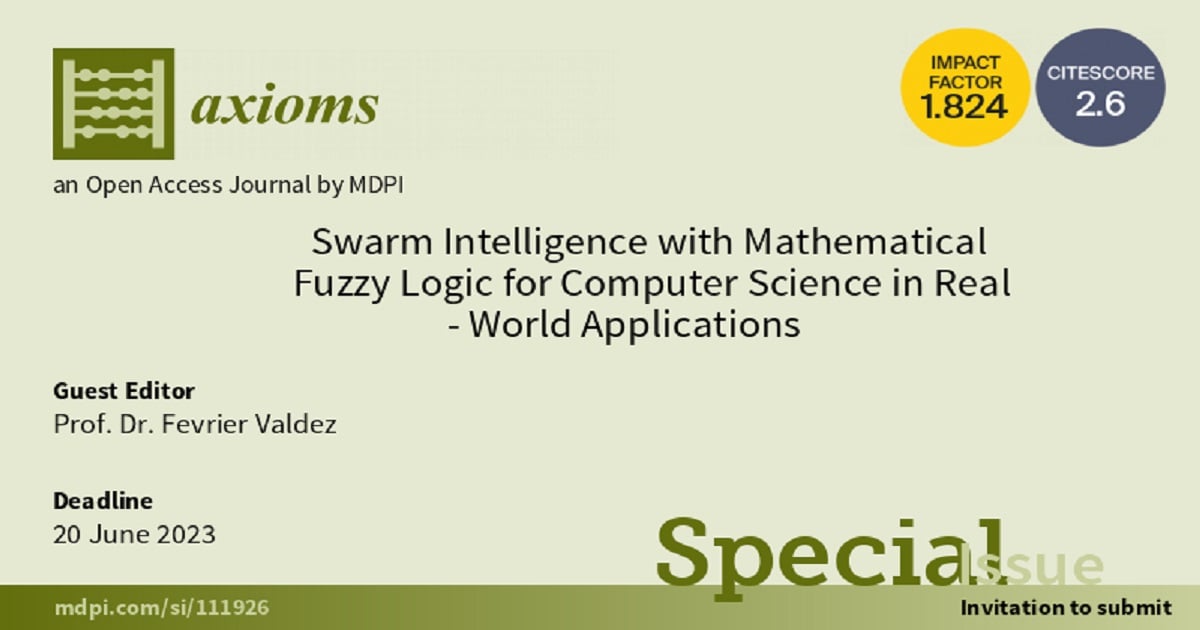Swarm Intelligence with Mathematical Fuzzy Logic for Computer Science in Real-World Applications
A special issue of Axioms (ISSN 2075-1680). This special issue belongs to the section "Logic".
Deadline for manuscript submissions: closed (20 June 2023) | Viewed by 24160

Special Issue Editor
Interests: optimization algorithms; swarm intelligence; bio-inspired algorithms; fuzzy logic; neural networks
Special Issues, Collections and Topics in MDPI journals
Special Issue Information
Dear Colleagues,
Optimization methods based on swarm intelligence are a recent topic of research based on using bio-inspired behavior to solve complex optimization in computational intelligence.
Several approaches have recently been developed in this area, such as particle swarm optimization, bat algorithm, ant colony optimization, bee colony, dolphin algorithm, wolf search, flower pollination algorithm, firefly, mayfly, ant colony, cuckoo search, termite colony, and cat swarm. However, determining how to design efficient methods and how to use these algorithms for real-world application problems is still an open issue—in particular, path planning of mobile robots by neural networks, the design of neuro-fuzzy models such as fuzzy neural networks, fuzzy parameter adaptation in control systems, and intuitionistic fuzzy neural networks have received some interest. In addition, new emerging neural models have recently been proposed. In all these models, a common problem is determining how to obtain an optimal topology, which can be handled by bio-inspired optimization algorithms.
This Special Issue invites researchers to report their latest research work on the development of new improved bio-inspired algorithms, or new applications of existing methods in the design of topologies of neural models, parameter adaptation in control systems and path planning of robots, etc., with ultimate goal of exploring future research directions.
Potential themes include but are not limited to the following:
- Theoretical methods for understanding the behavior of bio-inspired algorithms;
- Novel nature-inspired or application-inspired optimization algorithms;
- Statistical approaches for understanding the behavior of nature-inspired methods;
- Optimization of neuro-fuzzy models;
- Optimization of mathematical fuzzy logic models;
- Optimization of emergent neural models with nature-inspired algorithms;
- Mathematical fuzzy logic and intelligent and automatic control;
- Methods based on collective intelligence;
- Fuzzy control design for an autonomous mobile robot using optimization algorithms;
- Parameter adaptation using mathematical fuzzy models;
- Other bio-inspired methods and their applications.
Prof. Dr. Fevrier Valdez
Guest Editor
Manuscript Submission Information
Manuscripts should be submitted online at www.mdpi.com by registering and logging in to this website. Once you are registered, click here to go to the submission form. Manuscripts can be submitted until the deadline. All submissions that pass pre-check are peer-reviewed. Accepted papers will be published continuously in the journal (as soon as accepted) and will be listed together on the special issue website. Research articles, review articles as well as short communications are invited. For planned papers, a title and short abstract (about 100 words) can be sent to the Editorial Office for announcement on this website.
Submitted manuscripts should not have been published previously, nor be under consideration for publication elsewhere (except conference proceedings papers). All manuscripts are thoroughly refereed through a single-blind peer-review process. A guide for authors and other relevant information for submission of manuscripts is available on the Instructions for Authors page. Axioms is an international peer-reviewed open access monthly journal published by MDPI.
Please visit the Instructions for Authors page before submitting a manuscript. The Article Processing Charge (APC) for publication in this open access journal is 2400 CHF (Swiss Francs). Submitted papers should be well formatted and use good English. Authors may use MDPI's English editing service prior to publication or during author revisions.
Keywords
- swarm intelligence
- mathematical fuzzy logic
- optimization methods
- neural networks
- computational intelligence
Benefits of Publishing in a Special Issue
- Ease of navigation: Grouping papers by topic helps scholars navigate broad scope journals more efficiently.
- Greater discoverability: Special Issues support the reach and impact of scientific research. Articles in Special Issues are more discoverable and cited more frequently.
- Expansion of research network: Special Issues facilitate connections among authors, fostering scientific collaborations.
- External promotion: Articles in Special Issues are often promoted through the journal's social media, increasing their visibility.
- Reprint: MDPI Books provides the opportunity to republish successful Special Issues in book format, both online and in print.
Further information on MDPI's Special Issue policies can be found here.




